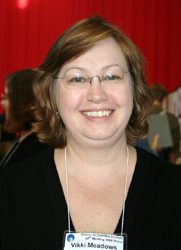EPOXI
Two intriguing investigations -- One flight-proven spacecraft
Victoria Meadows
Victoria Meadows
EPOCh Co-Investigator, U. Washington

What's the coolest thing about EPOXI?
That we get to study the full disk of the Earth as if it were an extrasolar planet, watching it rotate under the spacecraft. Lots of spacecraft have taken snap shots of the Earth on the way to some other planet, but here we get to study Earth itself over days and seasons.
Why do you like working at the University of Washington?
I spent the first half of my career working at NASA's JPL, which was a great experience, but I really am enjoying my recent start as a professor in the Astronomy Department and Astrobiology Program here at the University of Washington (UW). I'm an astrobiologist, and this is one of the best places in the world to do astrobiology, primarily because our astrobiology graduate students are awesome. I've been working with Ty Robinson and Nick Cowan on analyzing the Earth observing data and it's fantastic to have the energy and motivation of young scientists on your team!
What is your job on the EPOXI mission?
I'm one of the scientists responsible for analysis of the EPOXI Earth data. Specifically, we are comparing a model of the distant appearance of the Earth, which we developed as part of the NASA Astrobiology Institute, with the EPOXI data. This allows us to check whether our model is working correctly and to help improve it so that it is the best representation of the Earth possible. This is a scientific process called "validation." Now that the model is validated, Ty and Nick and I are using the model to predict how the Earth might appear to a distant observer with a telescope, if the Earth was orbiting around another star. We can search for those properties of the Earth that are detectable over interstellar distances that "give away" the fact that the Earth is able to support life. For example, we are using the model (and some other models) to figure out how we would tell if a planet around another star had an ocean, by looking for changes in the color of the planet over time, and changes in the brightness of the planet as it is seen at different positions around its star.
How did you end up in Space Science?
I wanted to be a biochemist in High School, but I read a LOT of science fiction. Eventually, between the science fiction and Carl Sagan's Cosmos TV series, I eventually decided to go into astronomy instead... but I really missed my biochemistry. And now I'm an astrobiologist, who is someone who works across scientific disciplines to understand the origin, evolution and distribution of life in the universe. I don't actually DO biology, but I used my astronomy and planetary science training to work along with biologists, geologists and atmospheric scientists to understand how we would look for life on extrasolar planets.
What do you do in your spare time?
Reading, kayaking and gardening. I love to garden, and Seattle is a great place for that!
Who in your life inspired you?
My high school science teacher, Mr. Scanes, and my PhD thesis advisors, Dr. David Allen, Dr. David Crisp and Prof. Dick Hunstead. All these people encouraged me in my efforts to do science, and were huge influences on my science career.
What is one yet-to-be achieved life goal?
I'd like to work on only one thing at a time. It will never happen.
Were you science-oriented as a young person?
Absolutely. Although English was always my best subject in school. My elementary school teachers thought I would grow up to be a writer, but my parents had to put up with me growing plants and keeping tadpoles in my room!
What was your favorite book as a young person?
Maybe not my favorite but my most memorable was a little paperback picture book on The Planets which I got from the school book club when I was about 6 yrs old. I think it cost about 10¢. It was printed in black and white and blue only, but it showed a picture of Jupiter being opened up and accepting lots and lots of Earths being poured into its interior, with 11 stacked across the equator. I loved that book.
If you weren't working in space exploration now, what might you be doing?
Landscape gardening or working in a library. Maybe when I retire...
